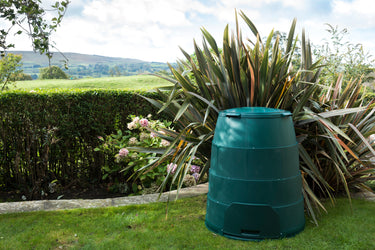Why Compost at Home?
Composting is a cheap, easy, and natural process that transforms your kitchen and organic waste into valuable, nutrient-rich feed for your garden. This guide will show you how to get started, and provide you with useful tips to get the best out of your compost to keep your plants and garden thriving.
Even for many households that already compost, new research states almost half of the food waste in their rubbish bins could have been put in the compost bin. Scientists have also calculated how composting at home for just one year can save global warming gases equivalent to all the CO2 your kettle produces annually, or your washing machine produces in 3 months!
Diverting waste away from landfill is becoming an increasingly desired procedure. This is because air (and oxygen) cannot sufficiently penetrate the eroding waste in landfill due to the vast amount that is being dumped. Subsequently, as the waste slowly breaks down, it emits toxic greenhouse gases, such as methane and carbon dioxide which corresponds to the warming of the planet.
However, when waste is composted above ground at home, the more open supply of oxygen helps break the organic material down, enabling it to decompose aerobically without the production of methane.
Composting is Easy: A Step by Step Guide
Find the right site
Ideally, site your compost bin in a reasonably sunny site on bare soil. If you have to put your compost bin on concrete, tarmac, or patio slabs, ensure there is a layer of paper and twigs, or existing compost on the bottom so worms and other creatures can colonise. Additionally, choose a place where you can easily add ingredients to the bin, and get your compost out.
Add the right ingredients
Have a container available, such as a kitchen caddy or an old ice cream tub so you can collect items for your compost bin from all over the garden. Fill your kitchen caddy with everything from fruit and vegetable peelings, to teabags, coffee ground, toilet roll tubes, cereal boxes, and eggshells. Take care not to compost cooked food, meat, or fish.
Fill it up
Empty your kitchen caddy along with your garden and organic waste into your compost bin. A 50/50 mix of greens and brown (see below) is the perfect recipe for rich and healthy compost.
Wait a while
It takes between nine and twelve months for your compost to become ready for use, so you may have to be a little patient as you wait for nature to take its course. Keep on adding greens and browns to top up your compost and keep the nutrients developing inside.
Ready for use
Once your compost has turned into a crumbly, dark material, resembling thick, moist soil and gives off an earthy, fresh aroma, you know it's ready to use.
Removing the compost
Lift the bin slightly or open the hatch at the bottom of your compost bin, and scoop out the fresh compost with a garden fork, spade or trowel.
Use it
Don't worry if your compost looks a little lumpy with twigs and bits of eggshells - this is perfectly normal. Use it to enrich borders and vegetable patches, plant up patio containers or feed the lawn.
Making Good Compost
The key to good compost lies in getting the mix right. You need to keep your greens and browns properly balanced. If your compost is too wet, and gives off an unpleasant odour, add more browns. However, if it is too dry and is not rotting, add some greens. Air is essential to the composting process and by mixing material up, as you fill your bin, it will create air pockets and help keep your compost healthy.
Put These In...
Like any recipe, your compost relies on the right ingredients to make it work. Good things you can compost include vegetable peelings, fruit waste, teabags, plant prunings and grass cuttings. These are considered "greens." Greens are quick to rot and they provide important nitrogen and moisture. Other things you can compost include cardboard egg and cereal boxes, scrunched up paper and small twigs. These are considered "browns" and are slower to rot. They provide fibre and carbon and also allow important air pockets to form in the mixture. Crushed eggshells can be included to add useful minerals too.
'Greens'
- Teabags
- Grass cuttings
- Vegetable peelings, salad leaves, and fruit scraps
- Old flowers and nettles
- Coffee grounds and filter paper
- Spent bedding plants
- Rhubarb leaves
- Young annual weeds (e.g. chickweed)
'Browns'
- Crushed egg shells
- Egg and cereal boxes
- Corrugated cardboard and paper (scrunched up)
- Toilet and kitchen roll tubes
- Garden prunings
- Twigs and hedge clippings
- Straw and hay
- Bedding from vegetarian pets
- Ashes from wood, paper and lumpwood charcoal
- Sawdust and wood chippings
- Wool
- Woody clippings
- Cotton threads and string (made from natural fibre)
- Feathers
- Old natural fibre clothes (cut into small pieces)
- Tissues, paper towels and napkins
- Shredded confidential documents
- Corn cobs and stalks
Keep These Out
Certain things should never be placed in your bin. Do not put in:
- Cooked vegetables, meat and dairy products (unless they have first been treated with a specialist Kitchen Composter)
- Diseased plants
- Dog poo, cat litter, or baby's nappies
Putting these in your bin can encourage unwanted pests and can also create odour. Also avoid composting perennial weeds (such as dandelions and thistles) or weeds with seed heads. Remember that plastics, glass and metals are not suitable for composting and should be recycled separately.
Finally, Your Compost is Ready For Use!
The time for putting that finished compost to use has finally arrived. Before starting, you'll want to find out if it actually is ready to go. You can do this by making sure your compost is dark brown and smells rich and earthy. It should also be slightly moist and have a crumbly texture.
It probably won't look exactly like the compost you buy at the shops and it's very likely that yours will still have twigs and eggshells in it. Don't worry, it's still perfectly good to use! Simply sift out any larger bits and return them to your compost bin.
Your fresh compost is nutrient-rich food for your garden and will help improve soil structure, maintain moisture levels, and keep your soil's PH balance in check while helping suppress plant disease. It has everything your plants need, including nitrogen, phosphorus and potassium and it will help buffer soils that are very acidic or alkaline. Compost improves your soil's condition and your plants and flowers will love it!
Getting the Compost Out of the Bin
Step 1
Remove the hatch at the bottom of the compost bin to see if the compost is ready. Finished compost should be dark brown, crumbly and moist with a nice earthy smell. It is likely that it will still have twigs and eggshells in it. If you only need a small amount of compost for potting purposes, then the hatch provides perfect access to remove a small amount with a trowel.
Step 2
If you have a Compost Converter and need lots of compost then it is best to remove the whole compost bin. To separate and loosen the material from the edges of the bin, push the bin backwards and forwards in a rocking motion. Lift the bin up and off. The contents will remain in situ, the bin itself acting a bit like a jelly mould. To make this easier it is a good idea to remove the hatch from the bottom completely so you can get a good grip on the bin.
Step 3
There are other compost bins available with different ways to access the finished compost. If you have a Thermo King bin the front and sides of this bin are easily removable to provide access to finished compost.
Step 4
Once you have removed or opened the bin you will be left with a 'compost cake'. You should have a plentiful supply of finished compost at the bottom, a middle layer of partially rotted material and your most recently added items at the top.
Step 5
Using a garden fork remove the top layers into a wheelbarrow - you can then add these back into the bin to continue rotting down for next year's compost.
Step 6
If you don't need to use all of your finished compost, you can bag it up for future use - you can store finished compost for up to a year. Old plastic sand bags are great for storing finished compost. Don't forget to always wear gloves when handling compost.
Using Your Compost
...on flowerbeds
Help your new plants and flowers bloom by digging a 10cm layer of compost into the soil prior to planting.
If your flowers have already been planted you simply need to spread a thin layer of compost-enriched soil around the base of the plants. Nutrients will work their way down to the roots and your plants will enjoy the healthy boost compost provides. It is important that you leave gaps around any soft stemmed plants.
...to enrich new borders
The borders of your garden will also greatly appreciate your compost.
Spread up to a 5cm layer of compost over the existing soil. Worms will quickly like getting to work mixing it in for you! Otherwise you can dig your finished compost into the soil prior to planting. It is important that you leave gaps around any soft stemmed plants.
...as mulch
Using your compost as mulch is a great idea.
By using 'rough' compost (where not everything has completely broken down) over flowerbeds and around shrubs, helps prevent soil erosion and will replenish much needed nutrients. A layer of about 5cm should do the trick. Make sure you leave a gap around any soft-stemmed plants. Adding mulch after it has rained will help keep the moisture in the soil.
...around trees
Compost is great for your trees. Spreading a 5-10cm layer around the roots will provide them with important nutrients and can protect against drought and disease.
Avoid the base of the tree and do not spread too close to the trunk. Your trees will also benefit from less weeds growing around them. Doing this once or twice a year will help your trees grow taller and bushier in no time at all.
...to replenish pots
Give your potted plants and containers an extra boost by removing the top few centimetres of existing soil and adding your freshly made compost.
Leave a gap around soft stemmed plants. This will provide food for your plants and flowers and is a great way to make them more healthy and robust.
...in patio containers
You can mix home compost with regular soil or leafmould to create your own healthy potting mixture for patio containers.
Your plants will enjoy the additional nutrients and minerals that your compost enriched potting mixture contains, and outdoor container plants will love it too.
About a third of the mix should be compost, slightly less when you are planting seeds. The reason for this is that home made compost is too strong to use on its own for planting into.
...healthier herbs & vegetables
Compost is excellent for growing herbs such as chives, parsley and mint.
Simply crumble it around the base of the plants for healthier, leafier herbs. Your vegetables will also grow better with compost added to their soil. Apply compost with each rotation - it's exceptionally good for planting potatoes and carrots.
...feeding your lawn
Dressing your lawn with compost helps young grass take root and can make your garden healthier and greener.
First, you'll need to sieve the compost and remove any large twigs or eggshells. Next, mix it with an even amount of sharp sand to compost as this will allow it to spread more easily. You'll want a layer of about 2.5cm. Mature lawns can really benefit from this little extra kick of nutrients but be aware that newly seeded or turfed lawns can be scorched by it.
FAQs
Q.I seem to have a lot of small black flies in my compost bin. Is this good for the compost or should I get rid of them?
A. Fruit flies do not carry disease and do not harm your compost. However, if you find them unpleasant you can reduce their numbers by ensuring that the organic waste destined for your bin is always covered in the kitchen or wherever it is stored. You can eradicate them by keeping the lid off your bin for 3 or 4 days, thus allowing the predator beetles to gain access and kill them for you; and by covering the compost surface with about an inch of soil to prevent the hatching flies from being able to escape. They are not an indicator of a failing bin.
Q. Why does my bin smell?
A. You need to introduce more oxygen in your compost bin so that your waste can break down aerobically. By mixing bulky items such as toilet roll tubes, cardboard or scrunched up or shredded paper into your bin you can introduce pockets of air.
Q. I've waited a while but I still don't have any compost at the bottom of my compost bin. Why is this?
A. Don't forget it takes 9-12 months to make finished compost. Keep adding a good balance of greens and browns and the creatures will keep composting everything down.
Q. Why do I get a lot of ants in my bin?
A. Ants are part of the home composting process but it could mean that your bin is too dry. For a quick fix, add some cold water to your bin. Over time, you need to add more 'green' nitrogen rich items such as grass cuttings and kitchen peelings to keep moisture levels up.
Q. Do compost bins attract rats?
A. Some people worry that having a compost bin could attract rats. But in fact there are many other reasons why rats may already be in the vicinity of your garden. For example if you live near water, farm land/open countryside or derelict buildings, you are likely to have rats living around the local area. They may be attracted into your garden, like other animals, to look for a dry place to shelter, for example under a shed or decking or to find food. One common source of food is over-feeding wild birds (leaving excess food exposed). A rat is only likely to seek out a compost bin in the garden if incorrect waste items have been composted, making the bin a source of food as well as a shelter. However, a compost bin that is used a lot will deter them.













